Commercial Law: Challenges in Copyright for Performers' Rights
VerifiedAdded on 2021/07/20
|8
|3549
|106
Essay
AI Summary
This essay critically analyzes the challenges involved in ensuring the copyrights of performers under intellectual property law, focusing on the impact of the digital environment. It explores the evolution of copyright law, its economic and moral rights, and the role of related rights. The essay examines the Sri Lankan context, comparing it with international legal frameworks and highlighting the vulnerabilities of performers' rights in the digital age. It discusses the implications of copyright infringement and suggests potential solutions, such as technological measures, automated monitoring, and clearer jurisdictional definitions. The analysis emphasizes the need to balance the interests of creators and the public, referencing relevant legal provisions and judicial interpretations to propose effective remedies for copyright violations in the digital landscape.
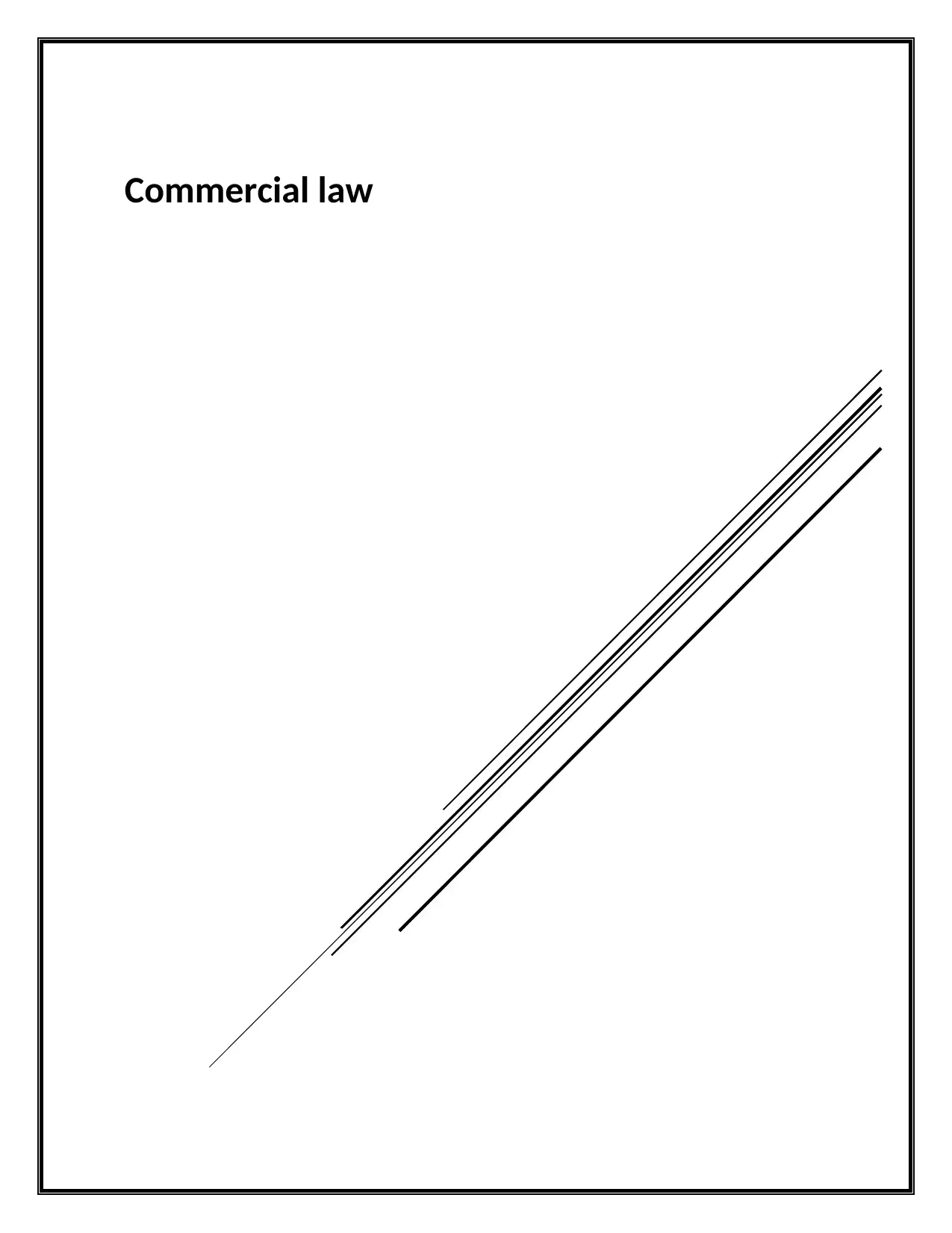
Commercial law
Paraphrase This Document
Need a fresh take? Get an instant paraphrase of this document with our AI Paraphraser
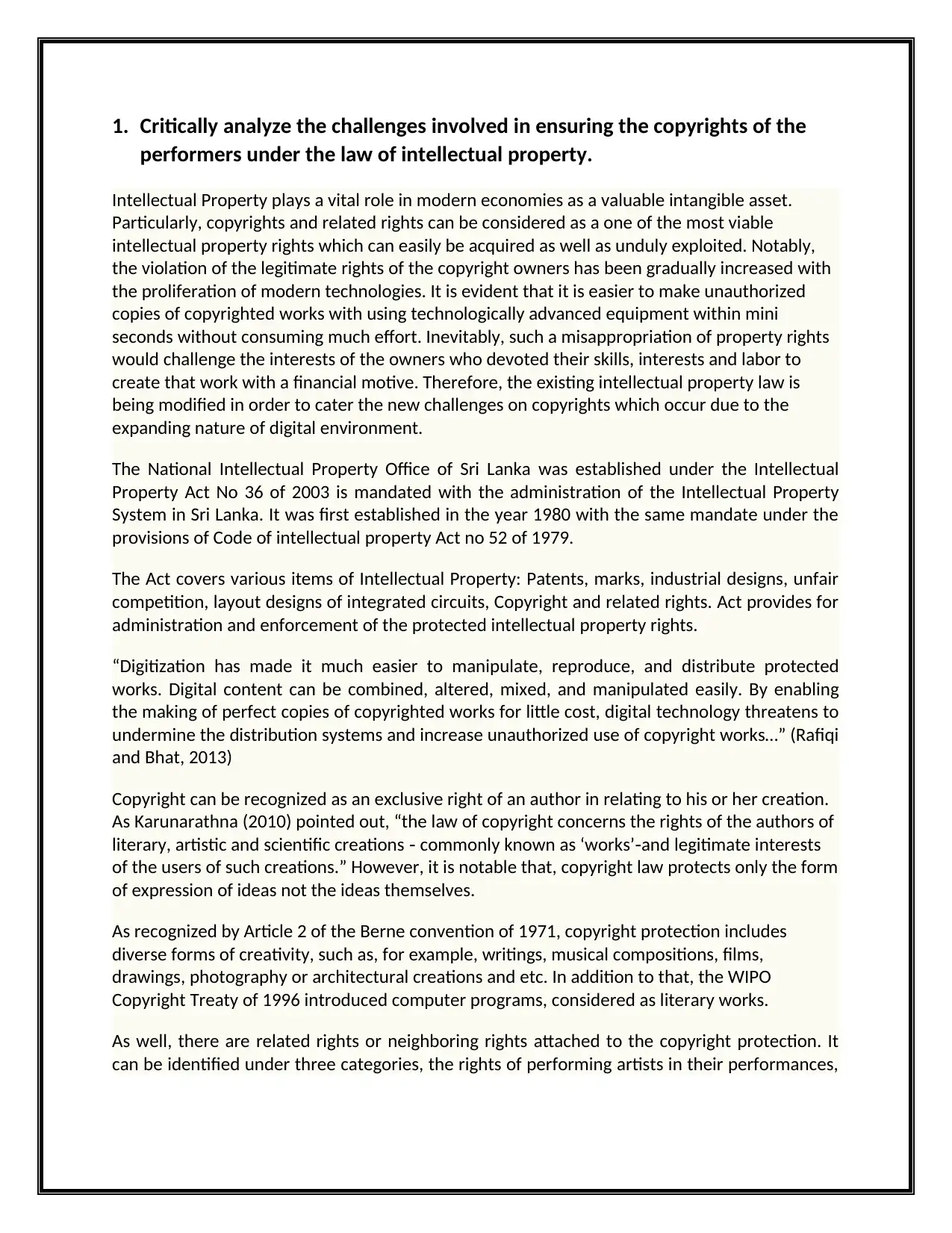
1. Critically analyze the challenges involved in ensuring the copyrights of the
performers under the law of intellectual property.
Intellectual Property plays a vital role in modern economies as a valuable intangible asset.
Particularly, copyrights and related rights can be considered as a one of the most viable
intellectual property rights which can easily be acquired as well as unduly exploited. Notably,
the violation of the legitimate rights of the copyright owners has been gradually increased with
the proliferation of modern technologies. It is evident that it is easier to make unauthorized
copies of copyrighted works with using technologically advanced equipment within mini
seconds without consuming much effort. Inevitably, such a misappropriation of property rights
would challenge the interests of the owners who devoted their skills, interests and labor to
create that work with a financial motive. Therefore, the existing intellectual property law is
being modified in order to cater the new challenges on copyrights which occur due to the
expanding nature of digital environment.
The National Intellectual Property Office of Sri Lanka was established under the Intellectual
Property Act No 36 of 2003 is mandated with the administration of the Intellectual Property
System in Sri Lanka. It was first established in the year 1980 with the same mandate under the
provisions of Code of intellectual property Act no 52 of 1979.
The Act covers various items of Intellectual Property: Patents, marks, industrial designs, unfair
competition, layout designs of integrated circuits, Copyright and related rights. Act provides for
administration and enforcement of the protected intellectual property rights.
“Digitization has made it much easier to manipulate, reproduce, and distribute protected
works. Digital content can be combined, altered, mixed, and manipulated easily. By enabling
the making of perfect copies of copyrighted works for little cost, digital technology threatens to
undermine the distribution systems and increase unauthorized use of copyright works…” (Rafiqi
and Bhat, 2013)
Copyright can be recognized as an exclusive right of an author in relating to his or her creation.
As Karunarathna (2010) pointed out, “the law of copyright concerns the rights of the authors of
literary, artistic and scientific creations ‐ commonly known as ‘works’ and legitimate interests‐
of the users of such creations.” However, it is notable that, copyright law protects only the form
of expression of ideas not the ideas themselves.
As recognized by Article 2 of the Berne convention of 1971, copyright protection includes
diverse forms of creativity, such as, for example, writings, musical compositions, films,
drawings, photography or architectural creations and etc. In addition to that, the WIPO
Copyright Treaty of 1996 introduced computer programs, considered as literary works.
As well, there are related rights or neighboring rights attached to the copyright protection. It
can be identified under three categories, the rights of performing artists in their performances,
performers under the law of intellectual property.
Intellectual Property plays a vital role in modern economies as a valuable intangible asset.
Particularly, copyrights and related rights can be considered as a one of the most viable
intellectual property rights which can easily be acquired as well as unduly exploited. Notably,
the violation of the legitimate rights of the copyright owners has been gradually increased with
the proliferation of modern technologies. It is evident that it is easier to make unauthorized
copies of copyrighted works with using technologically advanced equipment within mini
seconds without consuming much effort. Inevitably, such a misappropriation of property rights
would challenge the interests of the owners who devoted their skills, interests and labor to
create that work with a financial motive. Therefore, the existing intellectual property law is
being modified in order to cater the new challenges on copyrights which occur due to the
expanding nature of digital environment.
The National Intellectual Property Office of Sri Lanka was established under the Intellectual
Property Act No 36 of 2003 is mandated with the administration of the Intellectual Property
System in Sri Lanka. It was first established in the year 1980 with the same mandate under the
provisions of Code of intellectual property Act no 52 of 1979.
The Act covers various items of Intellectual Property: Patents, marks, industrial designs, unfair
competition, layout designs of integrated circuits, Copyright and related rights. Act provides for
administration and enforcement of the protected intellectual property rights.
“Digitization has made it much easier to manipulate, reproduce, and distribute protected
works. Digital content can be combined, altered, mixed, and manipulated easily. By enabling
the making of perfect copies of copyrighted works for little cost, digital technology threatens to
undermine the distribution systems and increase unauthorized use of copyright works…” (Rafiqi
and Bhat, 2013)
Copyright can be recognized as an exclusive right of an author in relating to his or her creation.
As Karunarathna (2010) pointed out, “the law of copyright concerns the rights of the authors of
literary, artistic and scientific creations ‐ commonly known as ‘works’ and legitimate interests‐
of the users of such creations.” However, it is notable that, copyright law protects only the form
of expression of ideas not the ideas themselves.
As recognized by Article 2 of the Berne convention of 1971, copyright protection includes
diverse forms of creativity, such as, for example, writings, musical compositions, films,
drawings, photography or architectural creations and etc. In addition to that, the WIPO
Copyright Treaty of 1996 introduced computer programs, considered as literary works.
As well, there are related rights or neighboring rights attached to the copyright protection. It
can be identified under three categories, the rights of performing artists in their performances,
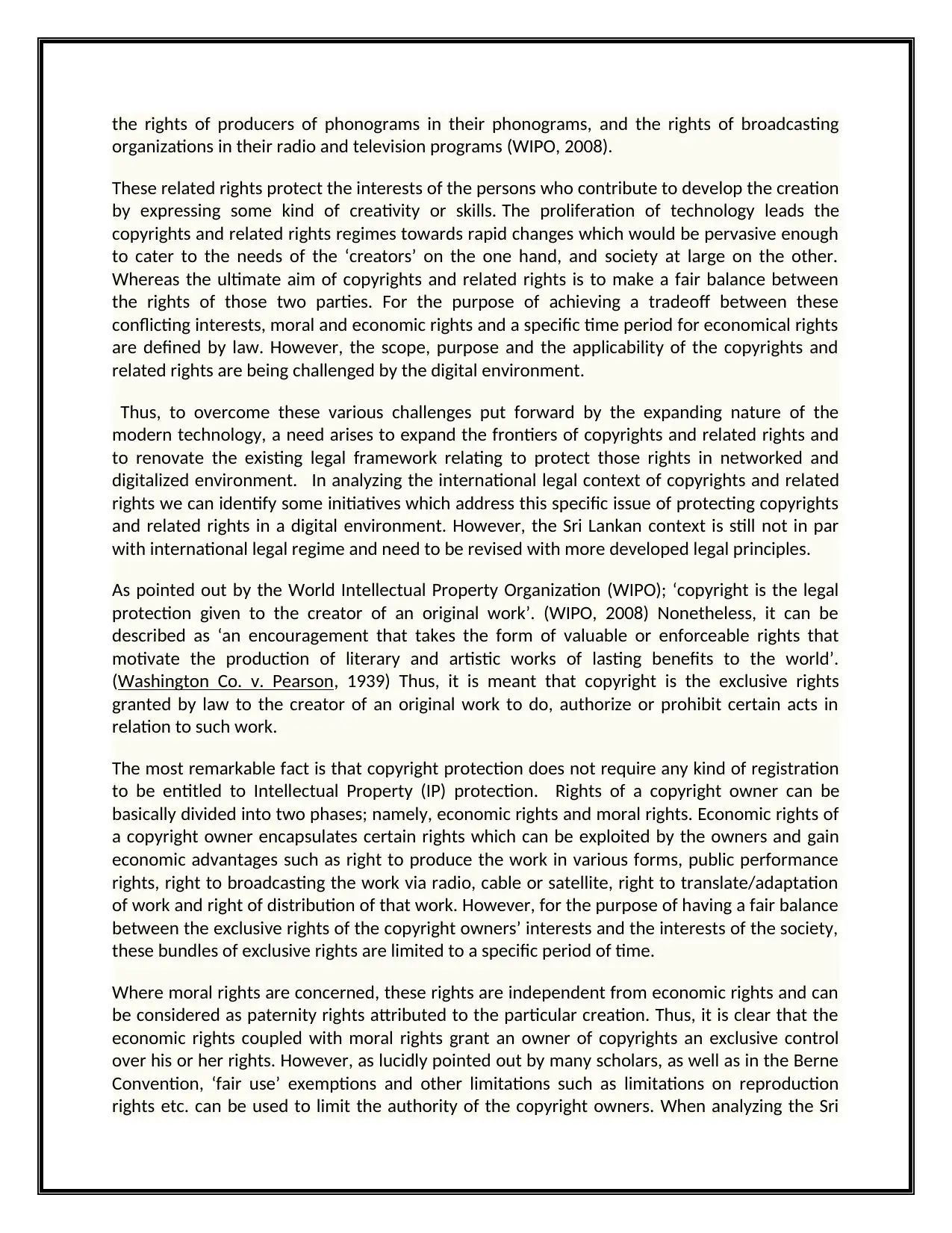
the rights of producers of phonograms in their phonograms, and the rights of broadcasting
organizations in their radio and television programs (WIPO, 2008).
These related rights protect the interests of the persons who contribute to develop the creation
by expressing some kind of creativity or skills. The proliferation of technology leads the
copyrights and related rights regimes towards rapid changes which would be pervasive enough
to cater to the needs of the ‘creators’ on the one hand, and society at large on the other.
Whereas the ultimate aim of copyrights and related rights is to make a fair balance between
the rights of those two parties. For the purpose of achieving a tradeoff between these
conflicting interests, moral and economic rights and a specific time period for economical rights
are defined by law. However, the scope, purpose and the applicability of the copyrights and
related rights are being challenged by the digital environment.
Thus, to overcome these various challenges put forward by the expanding nature of the
modern technology, a need arises to expand the frontiers of copyrights and related rights and
to renovate the existing legal framework relating to protect those rights in networked and
digitalized environment. In analyzing the international legal context of copyrights and related
rights we can identify some initiatives which address this specific issue of protecting copyrights
and related rights in a digital environment. However, the Sri Lankan context is still not in par
with international legal regime and need to be revised with more developed legal principles.
As pointed out by the World Intellectual Property Organization (WIPO); ‘copyright is the legal
protection given to the creator of an original work’. (WIPO, 2008) Nonetheless, it can be
described as ‘an encouragement that takes the form of valuable or enforceable rights that
motivate the production of literary and artistic works of lasting benefits to the world’.
(Washington Co. v. Pearson, 1939) Thus, it is meant that copyright is the exclusive rights
granted by law to the creator of an original work to do, authorize or prohibit certain acts in
relation to such work.
The most remarkable fact is that copyright protection does not require any kind of registration
to be entitled to Intellectual Property (IP) protection. Rights of a copyright owner can be
basically divided into two phases; namely, economic rights and moral rights. Economic rights of
a copyright owner encapsulates certain rights which can be exploited by the owners and gain
economic advantages such as right to produce the work in various forms, public performance
rights, right to broadcasting the work via radio, cable or satellite, right to translate/adaptation
of work and right of distribution of that work. However, for the purpose of having a fair balance
between the exclusive rights of the copyright owners’ interests and the interests of the society,
these bundles of exclusive rights are limited to a specific period of time.
Where moral rights are concerned, these rights are independent from economic rights and can
be considered as paternity rights attributed to the particular creation. Thus, it is clear that the
economic rights coupled with moral rights grant an owner of copyrights an exclusive control
over his or her rights. However, as lucidly pointed out by many scholars, as well as in the Berne
Convention, ‘fair use’ exemptions and other limitations such as limitations on reproduction
rights etc. can be used to limit the authority of the copyright owners. When analyzing the Sri
organizations in their radio and television programs (WIPO, 2008).
These related rights protect the interests of the persons who contribute to develop the creation
by expressing some kind of creativity or skills. The proliferation of technology leads the
copyrights and related rights regimes towards rapid changes which would be pervasive enough
to cater to the needs of the ‘creators’ on the one hand, and society at large on the other.
Whereas the ultimate aim of copyrights and related rights is to make a fair balance between
the rights of those two parties. For the purpose of achieving a tradeoff between these
conflicting interests, moral and economic rights and a specific time period for economical rights
are defined by law. However, the scope, purpose and the applicability of the copyrights and
related rights are being challenged by the digital environment.
Thus, to overcome these various challenges put forward by the expanding nature of the
modern technology, a need arises to expand the frontiers of copyrights and related rights and
to renovate the existing legal framework relating to protect those rights in networked and
digitalized environment. In analyzing the international legal context of copyrights and related
rights we can identify some initiatives which address this specific issue of protecting copyrights
and related rights in a digital environment. However, the Sri Lankan context is still not in par
with international legal regime and need to be revised with more developed legal principles.
As pointed out by the World Intellectual Property Organization (WIPO); ‘copyright is the legal
protection given to the creator of an original work’. (WIPO, 2008) Nonetheless, it can be
described as ‘an encouragement that takes the form of valuable or enforceable rights that
motivate the production of literary and artistic works of lasting benefits to the world’.
(Washington Co. v. Pearson, 1939) Thus, it is meant that copyright is the exclusive rights
granted by law to the creator of an original work to do, authorize or prohibit certain acts in
relation to such work.
The most remarkable fact is that copyright protection does not require any kind of registration
to be entitled to Intellectual Property (IP) protection. Rights of a copyright owner can be
basically divided into two phases; namely, economic rights and moral rights. Economic rights of
a copyright owner encapsulates certain rights which can be exploited by the owners and gain
economic advantages such as right to produce the work in various forms, public performance
rights, right to broadcasting the work via radio, cable or satellite, right to translate/adaptation
of work and right of distribution of that work. However, for the purpose of having a fair balance
between the exclusive rights of the copyright owners’ interests and the interests of the society,
these bundles of exclusive rights are limited to a specific period of time.
Where moral rights are concerned, these rights are independent from economic rights and can
be considered as paternity rights attributed to the particular creation. Thus, it is clear that the
economic rights coupled with moral rights grant an owner of copyrights an exclusive control
over his or her rights. However, as lucidly pointed out by many scholars, as well as in the Berne
Convention, ‘fair use’ exemptions and other limitations such as limitations on reproduction
rights etc. can be used to limit the authority of the copyright owners. When analyzing the Sri
⊘ This is a preview!⊘
Do you want full access?
Subscribe today to unlock all pages.

Trusted by 1+ million students worldwide
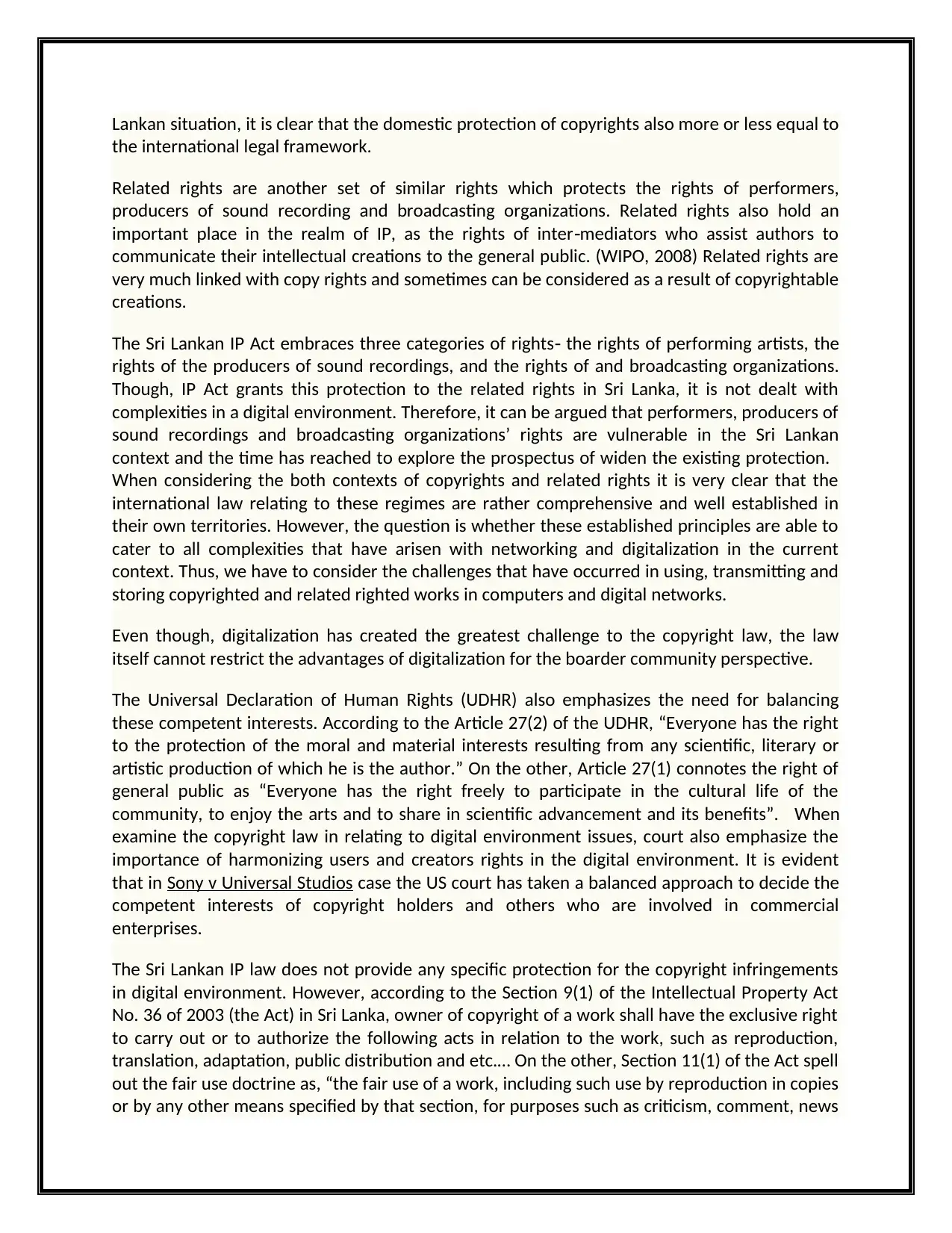
Lankan situation, it is clear that the domestic protection of copyrights also more or less equal to
the international legal framework.
Related rights are another set of similar rights which protects the rights of performers,
producers of sound recording and broadcasting organizations. Related rights also hold an
important place in the realm of IP, as the rights of inter mediators who assist authors to‐
communicate their intellectual creations to the general public. (WIPO, 2008) Related rights are
very much linked with copy rights and sometimes can be considered as a result of copyrightable
creations.
The Sri Lankan IP Act embraces three categories of rights‐ the rights of performing artists, the
rights of the producers of sound recordings, and the rights of and broadcasting organizations.
Though, IP Act grants this protection to the related rights in Sri Lanka, it is not dealt with
complexities in a digital environment. Therefore, it can be argued that performers, producers of
sound recordings and broadcasting organizations’ rights are vulnerable in the Sri Lankan
context and the time has reached to explore the prospectus of widen the existing protection.
When considering the both contexts of copyrights and related rights it is very clear that the
international law relating to these regimes are rather comprehensive and well established in
their own territories. However, the question is whether these established principles are able to
cater to all complexities that have arisen with networking and digitalization in the current
context. Thus, we have to consider the challenges that have occurred in using, transmitting and
storing copyrighted and related righted works in computers and digital networks.
Even though, digitalization has created the greatest challenge to the copyright law, the law
itself cannot restrict the advantages of digitalization for the boarder community perspective.
The Universal Declaration of Human Rights (UDHR) also emphasizes the need for balancing
these competent interests. According to the Article 27(2) of the UDHR, “Everyone has the right
to the protection of the moral and material interests resulting from any scientific, literary or
artistic production of which he is the author.” On the other, Article 27(1) connotes the right of
general public as “Everyone has the right freely to participate in the cultural life of the
community, to enjoy the arts and to share in scientific advancement and its benefits”. When
examine the copyright law in relating to digital environment issues, court also emphasize the
importance of harmonizing users and creators rights in the digital environment. It is evident
that in Sony v Universal Studios case the US court has taken a balanced approach to decide the
competent interests of copyright holders and others who are involved in commercial
enterprises.
The Sri Lankan IP law does not provide any specific protection for the copyright infringements
in digital environment. However, according to the Section 9(1) of the Intellectual Property Act
No. 36 of 2003 (the Act) in Sri Lanka, owner of copyright of a work shall have the exclusive right
to carry out or to authorize the following acts in relation to the work, such as reproduction,
translation, adaptation, public distribution and etc.… On the other, Section 11(1) of the Act spell
out the fair use doctrine as, “the fair use of a work, including such use by reproduction in copies
or by any other means specified by that section, for purposes such as criticism, comment, news
the international legal framework.
Related rights are another set of similar rights which protects the rights of performers,
producers of sound recording and broadcasting organizations. Related rights also hold an
important place in the realm of IP, as the rights of inter mediators who assist authors to‐
communicate their intellectual creations to the general public. (WIPO, 2008) Related rights are
very much linked with copy rights and sometimes can be considered as a result of copyrightable
creations.
The Sri Lankan IP Act embraces three categories of rights‐ the rights of performing artists, the
rights of the producers of sound recordings, and the rights of and broadcasting organizations.
Though, IP Act grants this protection to the related rights in Sri Lanka, it is not dealt with
complexities in a digital environment. Therefore, it can be argued that performers, producers of
sound recordings and broadcasting organizations’ rights are vulnerable in the Sri Lankan
context and the time has reached to explore the prospectus of widen the existing protection.
When considering the both contexts of copyrights and related rights it is very clear that the
international law relating to these regimes are rather comprehensive and well established in
their own territories. However, the question is whether these established principles are able to
cater to all complexities that have arisen with networking and digitalization in the current
context. Thus, we have to consider the challenges that have occurred in using, transmitting and
storing copyrighted and related righted works in computers and digital networks.
Even though, digitalization has created the greatest challenge to the copyright law, the law
itself cannot restrict the advantages of digitalization for the boarder community perspective.
The Universal Declaration of Human Rights (UDHR) also emphasizes the need for balancing
these competent interests. According to the Article 27(2) of the UDHR, “Everyone has the right
to the protection of the moral and material interests resulting from any scientific, literary or
artistic production of which he is the author.” On the other, Article 27(1) connotes the right of
general public as “Everyone has the right freely to participate in the cultural life of the
community, to enjoy the arts and to share in scientific advancement and its benefits”. When
examine the copyright law in relating to digital environment issues, court also emphasize the
importance of harmonizing users and creators rights in the digital environment. It is evident
that in Sony v Universal Studios case the US court has taken a balanced approach to decide the
competent interests of copyright holders and others who are involved in commercial
enterprises.
The Sri Lankan IP law does not provide any specific protection for the copyright infringements
in digital environment. However, according to the Section 9(1) of the Intellectual Property Act
No. 36 of 2003 (the Act) in Sri Lanka, owner of copyright of a work shall have the exclusive right
to carry out or to authorize the following acts in relation to the work, such as reproduction,
translation, adaptation, public distribution and etc.… On the other, Section 11(1) of the Act spell
out the fair use doctrine as, “the fair use of a work, including such use by reproduction in copies
or by any other means specified by that section, for purposes such as criticism, comment, news
Paraphrase This Document
Need a fresh take? Get an instant paraphrase of this document with our AI Paraphraser
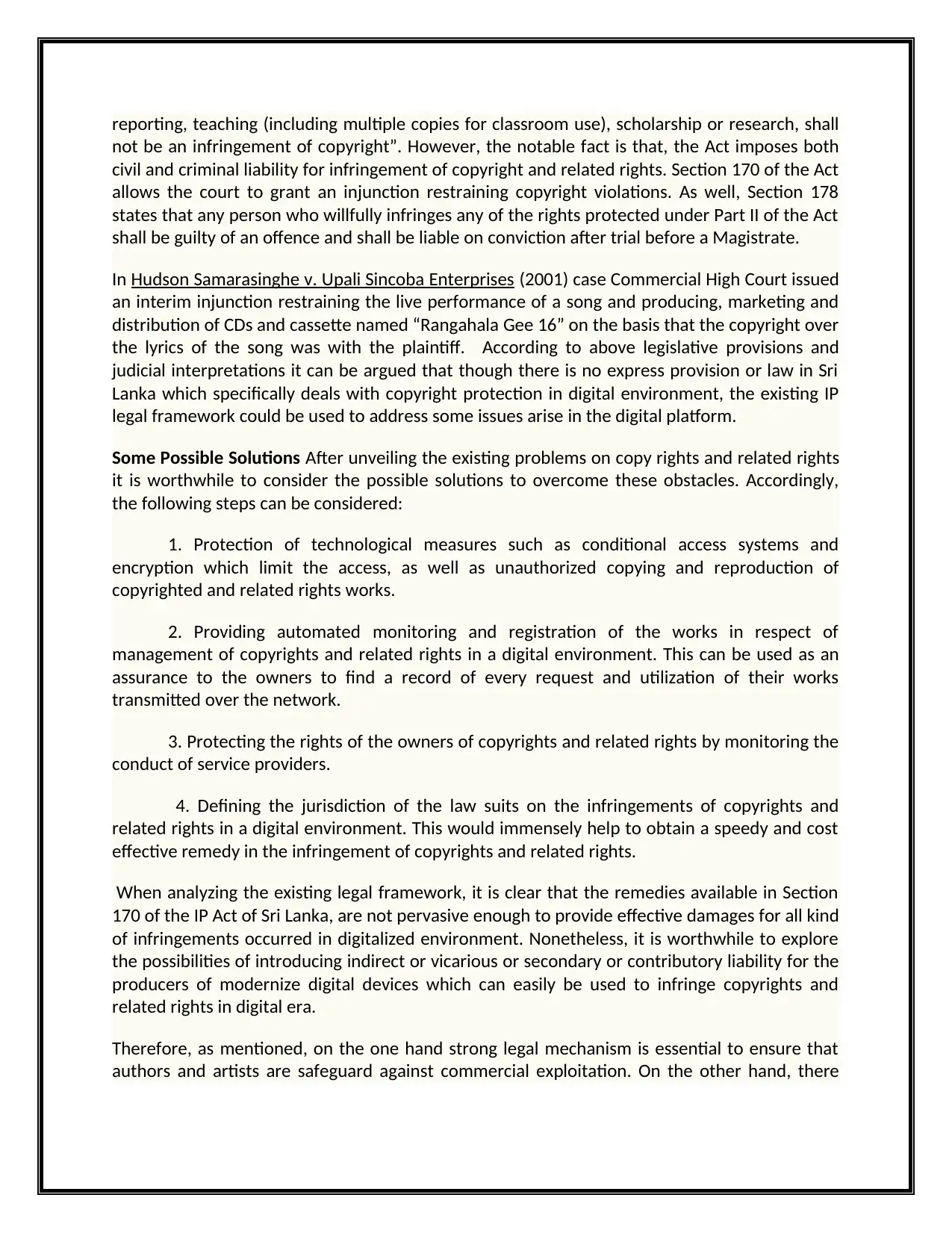
reporting, teaching (including multiple copies for classroom use), scholarship or research, shall
not be an infringement of copyright”. However, the notable fact is that, the Act imposes both
civil and criminal liability for infringement of copyright and related rights. Section 170 of the Act
allows the court to grant an injunction restraining copyright violations. As well, Section 178
states that any person who willfully infringes any of the rights protected under Part II of the Act
shall be guilty of an offence and shall be liable on conviction after trial before a Magistrate.
In Hudson Samarasinghe v. Upali Sincoba Enterprises (2001) case Commercial High Court issued
an interim injunction restraining the live performance of a song and producing, marketing and
distribution of CDs and cassette named “Rangahala Gee 16” on the basis that the copyright over
the lyrics of the song was with the plaintiff. According to above legislative provisions and
judicial interpretations it can be argued that though there is no express provision or law in Sri
Lanka which specifically deals with copyright protection in digital environment, the existing IP
legal framework could be used to address some issues arise in the digital platform.
Some Possible Solutions After unveiling the existing problems on copy rights and related rights
it is worthwhile to consider the possible solutions to overcome these obstacles. Accordingly,
the following steps can be considered:
1. Protection of technological measures such as conditional access systems and
encryption which limit the access, as well as unauthorized copying and reproduction of
copyrighted and related rights works.
2. Providing automated monitoring and registration of the works in respect of
management of copyrights and related rights in a digital environment. This can be used as an
assurance to the owners to find a record of every request and utilization of their works
transmitted over the network.
3. Protecting the rights of the owners of copyrights and related rights by monitoring the
conduct of service providers.
4. Defining the jurisdiction of the law suits on the infringements of copyrights and
related rights in a digital environment. This would immensely help to obtain a speedy and cost
effective remedy in the infringement of copyrights and related rights.
When analyzing the existing legal framework, it is clear that the remedies available in Section
170 of the IP Act of Sri Lanka, are not pervasive enough to provide effective damages for all kind
of infringements occurred in digitalized environment. Nonetheless, it is worthwhile to explore
the possibilities of introducing indirect or vicarious or secondary or contributory liability for the
producers of modernize digital devices which can easily be used to infringe copyrights and
related rights in digital era.
Therefore, as mentioned, on the one hand strong legal mechanism is essential to ensure that
authors and artists are safeguard against commercial exploitation. On the other hand, there
not be an infringement of copyright”. However, the notable fact is that, the Act imposes both
civil and criminal liability for infringement of copyright and related rights. Section 170 of the Act
allows the court to grant an injunction restraining copyright violations. As well, Section 178
states that any person who willfully infringes any of the rights protected under Part II of the Act
shall be guilty of an offence and shall be liable on conviction after trial before a Magistrate.
In Hudson Samarasinghe v. Upali Sincoba Enterprises (2001) case Commercial High Court issued
an interim injunction restraining the live performance of a song and producing, marketing and
distribution of CDs and cassette named “Rangahala Gee 16” on the basis that the copyright over
the lyrics of the song was with the plaintiff. According to above legislative provisions and
judicial interpretations it can be argued that though there is no express provision or law in Sri
Lanka which specifically deals with copyright protection in digital environment, the existing IP
legal framework could be used to address some issues arise in the digital platform.
Some Possible Solutions After unveiling the existing problems on copy rights and related rights
it is worthwhile to consider the possible solutions to overcome these obstacles. Accordingly,
the following steps can be considered:
1. Protection of technological measures such as conditional access systems and
encryption which limit the access, as well as unauthorized copying and reproduction of
copyrighted and related rights works.
2. Providing automated monitoring and registration of the works in respect of
management of copyrights and related rights in a digital environment. This can be used as an
assurance to the owners to find a record of every request and utilization of their works
transmitted over the network.
3. Protecting the rights of the owners of copyrights and related rights by monitoring the
conduct of service providers.
4. Defining the jurisdiction of the law suits on the infringements of copyrights and
related rights in a digital environment. This would immensely help to obtain a speedy and cost
effective remedy in the infringement of copyrights and related rights.
When analyzing the existing legal framework, it is clear that the remedies available in Section
170 of the IP Act of Sri Lanka, are not pervasive enough to provide effective damages for all kind
of infringements occurred in digitalized environment. Nonetheless, it is worthwhile to explore
the possibilities of introducing indirect or vicarious or secondary or contributory liability for the
producers of modernize digital devices which can easily be used to infringe copyrights and
related rights in digital era.
Therefore, as mentioned, on the one hand strong legal mechanism is essential to ensure that
authors and artists are safeguard against commercial exploitation. On the other hand, there
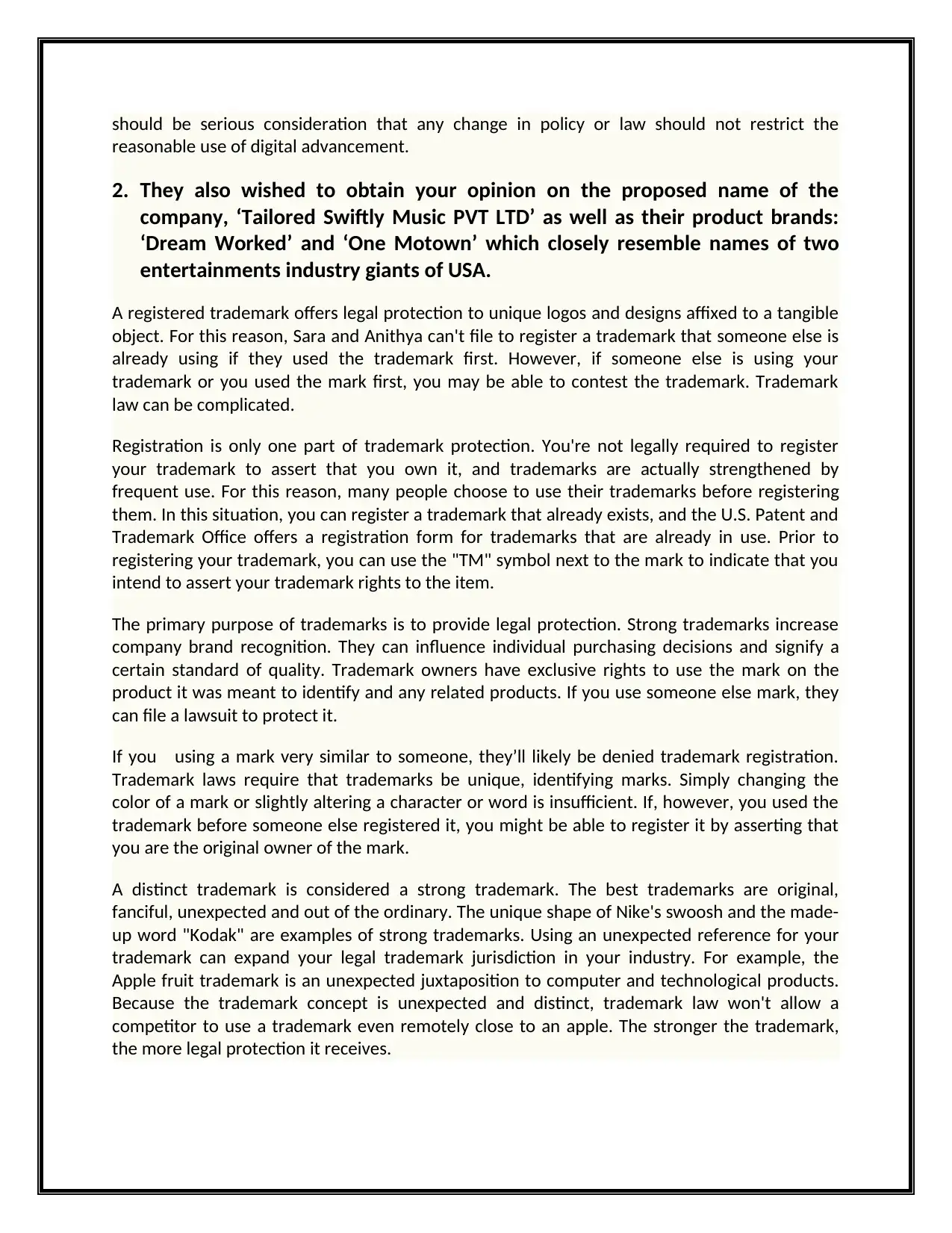
should be serious consideration that any change in policy or law should not restrict the
reasonable use of digital advancement.
2. They also wished to obtain your opinion on the proposed name of the
company, ‘Tailored Swiftly Music PVT LTD’ as well as their product brands:
‘Dream Worked’ and ‘One Motown’ which closely resemble names of two
entertainments industry giants of USA.
A registered trademark offers legal protection to unique logos and designs affixed to a tangible
object. For this reason, Sara and Anithya can't file to register a trademark that someone else is
already using if they used the trademark first. However, if someone else is using your
trademark or you used the mark first, you may be able to contest the trademark. Trademark
law can be complicated.
Registration is only one part of trademark protection. You're not legally required to register
your trademark to assert that you own it, and trademarks are actually strengthened by
frequent use. For this reason, many people choose to use their trademarks before registering
them. In this situation, you can register a trademark that already exists, and the U.S. Patent and
Trademark Office offers a registration form for trademarks that are already in use. Prior to
registering your trademark, you can use the "TM" symbol next to the mark to indicate that you
intend to assert your trademark rights to the item.
The primary purpose of trademarks is to provide legal protection. Strong trademarks increase
company brand recognition. They can influence individual purchasing decisions and signify a
certain standard of quality. Trademark owners have exclusive rights to use the mark on the
product it was meant to identify and any related products. If you use someone else mark, they
can file a lawsuit to protect it.
If you using a mark very similar to someone, they’ll likely be denied trademark registration.
Trademark laws require that trademarks be unique, identifying marks. Simply changing the
color of a mark or slightly altering a character or word is insufficient. If, however, you used the
trademark before someone else registered it, you might be able to register it by asserting that
you are the original owner of the mark.
A distinct trademark is considered a strong trademark. The best trademarks are original,
fanciful, unexpected and out of the ordinary. The unique shape of Nike's swoosh and the made-
up word "Kodak" are examples of strong trademarks. Using an unexpected reference for your
trademark can expand your legal trademark jurisdiction in your industry. For example, the
Apple fruit trademark is an unexpected juxtaposition to computer and technological products.
Because the trademark concept is unexpected and distinct, trademark law won't allow a
competitor to use a trademark even remotely close to an apple. The stronger the trademark,
the more legal protection it receives.
reasonable use of digital advancement.
2. They also wished to obtain your opinion on the proposed name of the
company, ‘Tailored Swiftly Music PVT LTD’ as well as their product brands:
‘Dream Worked’ and ‘One Motown’ which closely resemble names of two
entertainments industry giants of USA.
A registered trademark offers legal protection to unique logos and designs affixed to a tangible
object. For this reason, Sara and Anithya can't file to register a trademark that someone else is
already using if they used the trademark first. However, if someone else is using your
trademark or you used the mark first, you may be able to contest the trademark. Trademark
law can be complicated.
Registration is only one part of trademark protection. You're not legally required to register
your trademark to assert that you own it, and trademarks are actually strengthened by
frequent use. For this reason, many people choose to use their trademarks before registering
them. In this situation, you can register a trademark that already exists, and the U.S. Patent and
Trademark Office offers a registration form for trademarks that are already in use. Prior to
registering your trademark, you can use the "TM" symbol next to the mark to indicate that you
intend to assert your trademark rights to the item.
The primary purpose of trademarks is to provide legal protection. Strong trademarks increase
company brand recognition. They can influence individual purchasing decisions and signify a
certain standard of quality. Trademark owners have exclusive rights to use the mark on the
product it was meant to identify and any related products. If you use someone else mark, they
can file a lawsuit to protect it.
If you using a mark very similar to someone, they’ll likely be denied trademark registration.
Trademark laws require that trademarks be unique, identifying marks. Simply changing the
color of a mark or slightly altering a character or word is insufficient. If, however, you used the
trademark before someone else registered it, you might be able to register it by asserting that
you are the original owner of the mark.
A distinct trademark is considered a strong trademark. The best trademarks are original,
fanciful, unexpected and out of the ordinary. The unique shape of Nike's swoosh and the made-
up word "Kodak" are examples of strong trademarks. Using an unexpected reference for your
trademark can expand your legal trademark jurisdiction in your industry. For example, the
Apple fruit trademark is an unexpected juxtaposition to computer and technological products.
Because the trademark concept is unexpected and distinct, trademark law won't allow a
competitor to use a trademark even remotely close to an apple. The stronger the trademark,
the more legal protection it receives.
⊘ This is a preview!⊘
Do you want full access?
Subscribe today to unlock all pages.

Trusted by 1+ million students worldwide
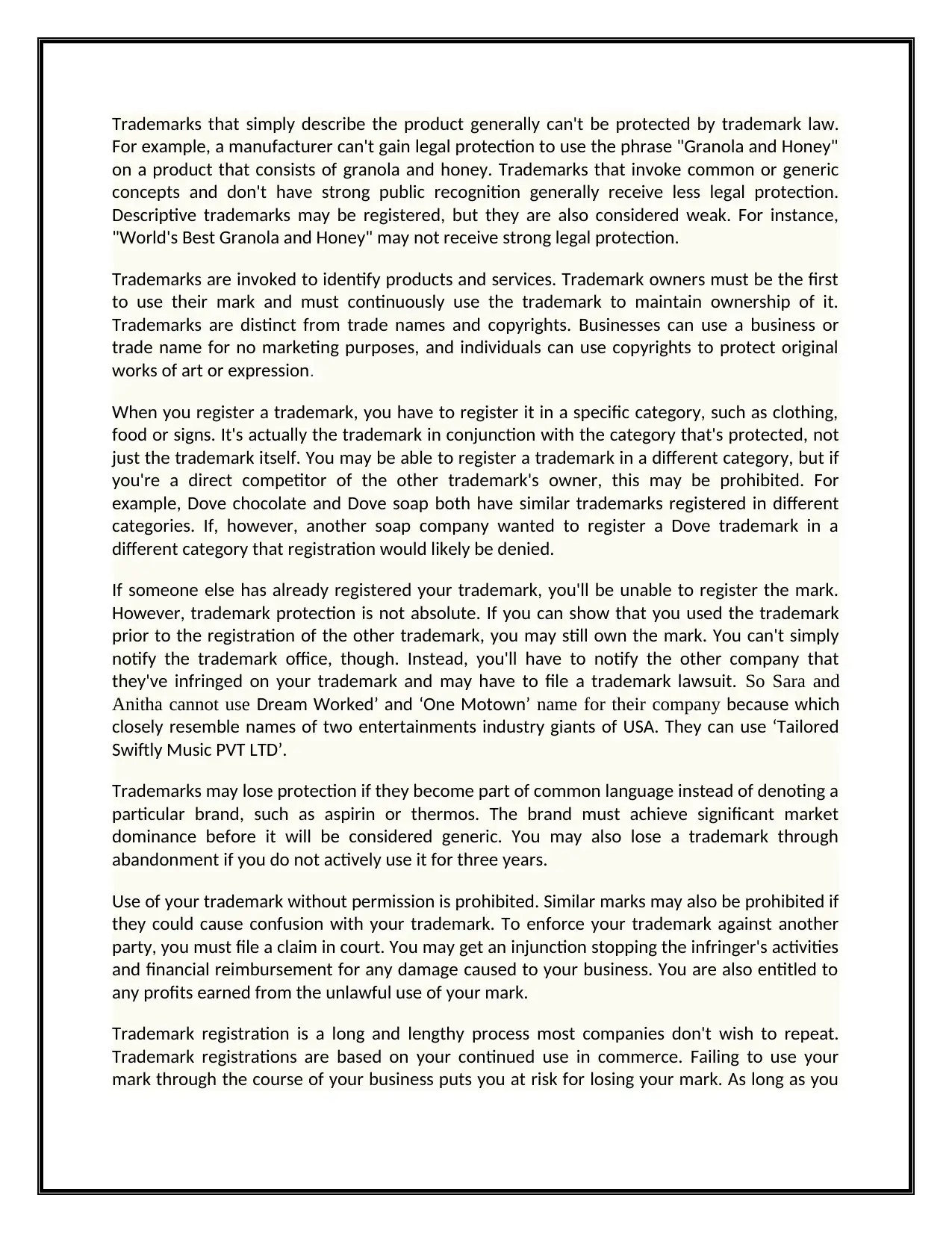
Trademarks that simply describe the product generally can't be protected by trademark law.
For example, a manufacturer can't gain legal protection to use the phrase "Granola and Honey"
on a product that consists of granola and honey. Trademarks that invoke common or generic
concepts and don't have strong public recognition generally receive less legal protection.
Descriptive trademarks may be registered, but they are also considered weak. For instance,
"World's Best Granola and Honey" may not receive strong legal protection.
Trademarks are invoked to identify products and services. Trademark owners must be the first
to use their mark and must continuously use the trademark to maintain ownership of it.
Trademarks are distinct from trade names and copyrights. Businesses can use a business or
trade name for no marketing purposes, and individuals can use copyrights to protect original
works of art or expression.
When you register a trademark, you have to register it in a specific category, such as clothing,
food or signs. It's actually the trademark in conjunction with the category that's protected, not
just the trademark itself. You may be able to register a trademark in a different category, but if
you're a direct competitor of the other trademark's owner, this may be prohibited. For
example, Dove chocolate and Dove soap both have similar trademarks registered in different
categories. If, however, another soap company wanted to register a Dove trademark in a
different category that registration would likely be denied.
If someone else has already registered your trademark, you'll be unable to register the mark.
However, trademark protection is not absolute. If you can show that you used the trademark
prior to the registration of the other trademark, you may still own the mark. You can't simply
notify the trademark office, though. Instead, you'll have to notify the other company that
they've infringed on your trademark and may have to file a trademark lawsuit. So Sara and
Anitha cannot use Dream Worked’ and ‘One Motown’ name for their company because which
closely resemble names of two entertainments industry giants of USA. They can use ‘Tailored
Swiftly Music PVT LTD’.
Trademarks may lose protection if they become part of common language instead of denoting a
particular brand, such as aspirin or thermos. The brand must achieve significant market
dominance before it will be considered generic. You may also lose a trademark through
abandonment if you do not actively use it for three years.
Use of your trademark without permission is prohibited. Similar marks may also be prohibited if
they could cause confusion with your trademark. To enforce your trademark against another
party, you must file a claim in court. You may get an injunction stopping the infringer's activities
and financial reimbursement for any damage caused to your business. You are also entitled to
any profits earned from the unlawful use of your mark.
Trademark registration is a long and lengthy process most companies don't wish to repeat.
Trademark registrations are based on your continued use in commerce. Failing to use your
mark through the course of your business puts you at risk for losing your mark. As long as you
For example, a manufacturer can't gain legal protection to use the phrase "Granola and Honey"
on a product that consists of granola and honey. Trademarks that invoke common or generic
concepts and don't have strong public recognition generally receive less legal protection.
Descriptive trademarks may be registered, but they are also considered weak. For instance,
"World's Best Granola and Honey" may not receive strong legal protection.
Trademarks are invoked to identify products and services. Trademark owners must be the first
to use their mark and must continuously use the trademark to maintain ownership of it.
Trademarks are distinct from trade names and copyrights. Businesses can use a business or
trade name for no marketing purposes, and individuals can use copyrights to protect original
works of art or expression.
When you register a trademark, you have to register it in a specific category, such as clothing,
food or signs. It's actually the trademark in conjunction with the category that's protected, not
just the trademark itself. You may be able to register a trademark in a different category, but if
you're a direct competitor of the other trademark's owner, this may be prohibited. For
example, Dove chocolate and Dove soap both have similar trademarks registered in different
categories. If, however, another soap company wanted to register a Dove trademark in a
different category that registration would likely be denied.
If someone else has already registered your trademark, you'll be unable to register the mark.
However, trademark protection is not absolute. If you can show that you used the trademark
prior to the registration of the other trademark, you may still own the mark. You can't simply
notify the trademark office, though. Instead, you'll have to notify the other company that
they've infringed on your trademark and may have to file a trademark lawsuit. So Sara and
Anitha cannot use Dream Worked’ and ‘One Motown’ name for their company because which
closely resemble names of two entertainments industry giants of USA. They can use ‘Tailored
Swiftly Music PVT LTD’.
Trademarks may lose protection if they become part of common language instead of denoting a
particular brand, such as aspirin or thermos. The brand must achieve significant market
dominance before it will be considered generic. You may also lose a trademark through
abandonment if you do not actively use it for three years.
Use of your trademark without permission is prohibited. Similar marks may also be prohibited if
they could cause confusion with your trademark. To enforce your trademark against another
party, you must file a claim in court. You may get an injunction stopping the infringer's activities
and financial reimbursement for any damage caused to your business. You are also entitled to
any profits earned from the unlawful use of your mark.
Trademark registration is a long and lengthy process most companies don't wish to repeat.
Trademark registrations are based on your continued use in commerce. Failing to use your
mark through the course of your business puts you at risk for losing your mark. As long as you
Paraphrase This Document
Need a fresh take? Get an instant paraphrase of this document with our AI Paraphraser
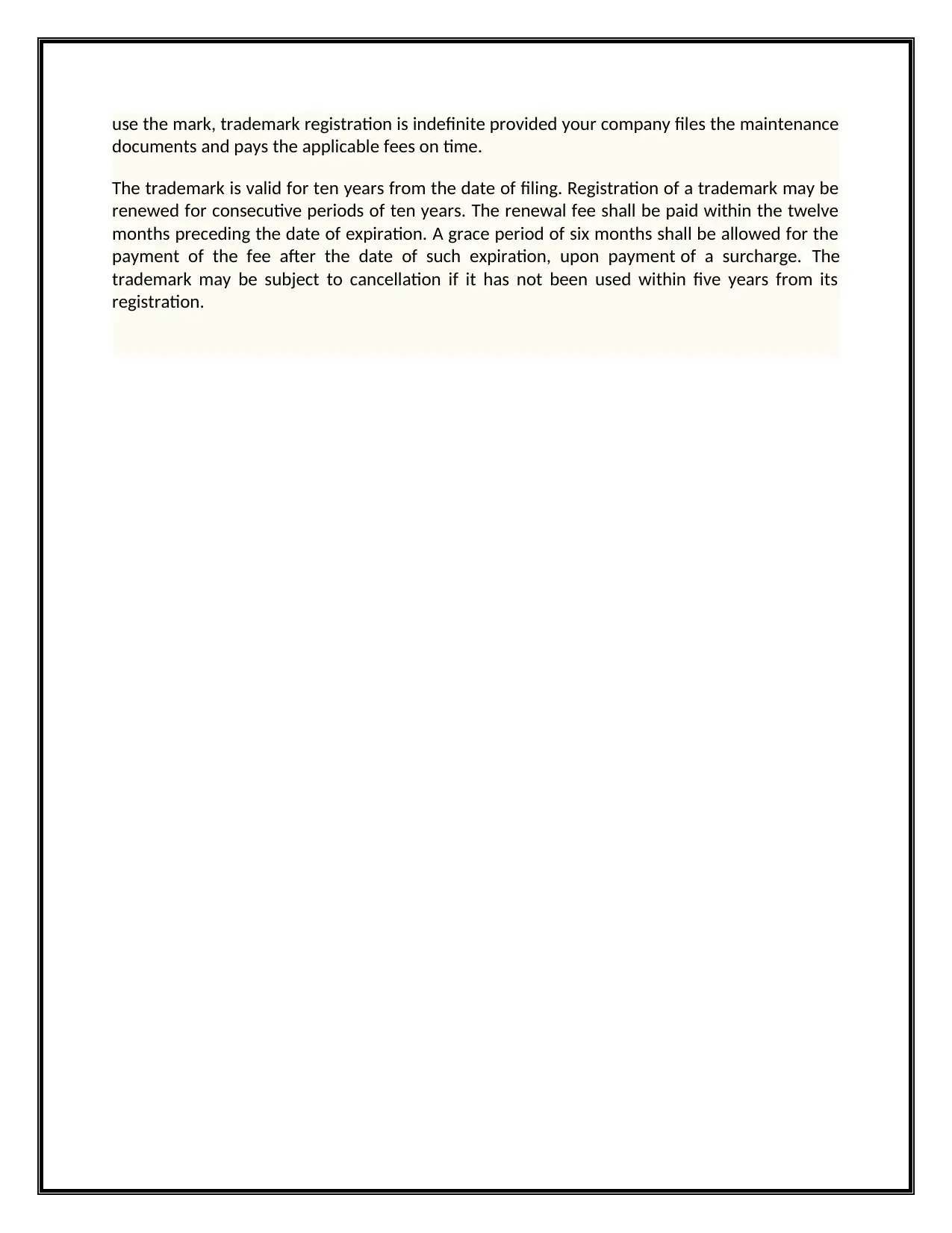
use the mark, trademark registration is indefinite provided your company files the maintenance
documents and pays the applicable fees on time.
The trademark is valid for ten years from the date of filing. Registration of a trademark may be
renewed for consecutive periods of ten years. The renewal fee shall be paid within the twelve
months preceding the date of expiration. A grace period of six months shall be allowed for the
payment of the fee after the date of such expiration, upon payment of a surcharge. The
trademark may be subject to cancellation if it has not been used within five years from its
registration.
documents and pays the applicable fees on time.
The trademark is valid for ten years from the date of filing. Registration of a trademark may be
renewed for consecutive periods of ten years. The renewal fee shall be paid within the twelve
months preceding the date of expiration. A grace period of six months shall be allowed for the
payment of the fee after the date of such expiration, upon payment of a surcharge. The
trademark may be subject to cancellation if it has not been used within five years from its
registration.
1 out of 8
Related Documents
Your All-in-One AI-Powered Toolkit for Academic Success.
+13062052269
info@desklib.com
Available 24*7 on WhatsApp / Email
![[object Object]](/_next/static/media/star-bottom.7253800d.svg)
Unlock your academic potential
Copyright © 2020–2025 A2Z Services. All Rights Reserved. Developed and managed by ZUCOL.




